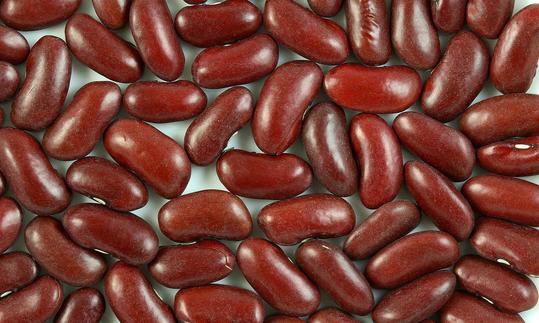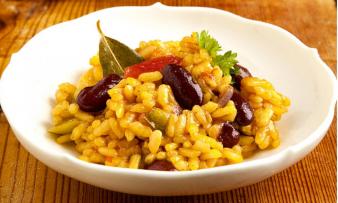Table of contents
Kidney beans are the large, red seeds of the common bean ( Phaseolus vulgaris). They contain a lot of fiber and protein.
Use in the kitchen
Kidney beans get their name from their typical kidney shape. The shell is reddish-brown in color, the inside is white-cream colored. Due to their sweet, nutty taste and tender texture, they are particularly popular with children. They are closely related to white beans.
They are popular in Mexican dishes, for example in "chilli con carne", for which there are many delicious, meat-free alternatives (chilli-sin-carne) or in Cajun cornbread casserole. A delicious dish from Spain with kidney beans is Murcia-style rice with saffron. They are also a popular ingredient in soups and raw vegetable salads, for example in the Mexican quinoa salad with avocado.
The beans can be bought dried and packaged or in the form of cooked beans in cans or jars. Raw kidney beans are poisonous due to the lectin they contain. You therefore always have to soak them and then cook or sprout them before you can eat them. Cooking dried or fresh kidney beans yourself has many advantages, more about this under the ingredient kidney beans, cooked.
Vegan recipes for kidney bean patties
Ingredients (for 4 people): 1 red onion, 2 cloves of garlic, 1 carrot, 1 tbsp rapeseed oil, 15 g tomato paste, 60 g oat flakes, 4 walnuts, 1 bunch of fresh parsley, 500 g cooked kidney beans (see preparation under link),black pepper, salt, hot paprika powder, ground cumin, drinking water if necessary.
Preparation: Peel and finely chop the onion, garlic and carrots. Put the rapeseed oil in a frying pan, heat it and sauté the onions, garlic and carrots over a medium heat for 3 minutes. Add the tomato paste and roast for 2-3 minutes. In the meantime, finely chop the walnuts. Wash the parsley, shake dry and chop. If necessary, finely grind the oat flakes in a mortar or mill. Mash the kidney beans with a fork. Put all the prepared ingredients in a bowl and season with salt, black pepper, paprika powder and cumin. Knead vigorously with your hands and form 12 small patties from the mixture. Bake the patties on a baking tray lined with baking paper at 200° C for 10-15 minutes. A date sauce, a salsa verde or a mango and pineapple salsa goes well with this.
Vegan recipes with kidney beans can be found under the note: " Recipes that have the most of this ingredient ".
| Not only vegans or vegetarians should read this: Vegans often eat unhealthily. Avoidable nutritional errors. |
Purchasing - Storage
Kidney beans can be bought dried or cooked in jars or tins, sometimes even in organic quality. They are available all year round. They are usually available in the large supermarket chains such as Coop, Migros, Spar, Rewe, Edeka, Hofer, Aldi, Denner, Volg, Lidl and Billa. Kidney beans are also available in organic supermarkets such as Denn's Biomarkt or Alnatura or in health food stores. Regionally grown beans have their main season between April and September. 19
The availability of kidney beans in the supermarkets mentioned varies depending on the size of the store, catchment area, etc. If you are interested, click on our recorded food prices for the DA-CH countries (above under the ingredient image). There you will find current prices from various supermarkets and their price development.
Storage tips
Dried kidney beans can be stored in tightly closed jars or cans, or in the original packaging, in a dry place for one to two years. 3
Ingredients - Nutritional values - Calories
Raw kidney beans (organic) contain 333 kcal per 100 g. They are very rich in fiber with 25.0 g/100g. 100 g of beans contain 24.0 g of protein and 60 g of carbohydrates. The fat content is low at 0.83 g/100g. 1
Kidney beans contain a lot of folate (folic acid) at 394 µg/100g. When cooked, the content drops to 130 µg/100g, which still corresponds to 65% of the daily requirement. Cooked white beans andcooked black beans have a similar folate content at 102 µg and 149 µg per 100g respectively, as do cooked lentils at 181 µg. 1
The protein-rich beans contain all eight essential amino acids. Tryptophan and threonine are abundant, with 0.28 g and 0.99 g per 100 g respectively. This corresponds to 113% and 107% of the daily requirement. However, the content decreases when cooked to 0.10 g and 0.32 g per 100 g respectively. 1
Potassium is also plentiful at 1,406 mg/100g. However, this is lost in the water during washing and cooking, which is why cooked kidney beans only contain around 405 mg/100g. Broad beans also contain plenty of potassium at 1,062 mg/100g. Unlike kidney beans, these can be eaten raw in small quantities. Potassium is also plentiful in cooked soybeans (515 mg), spinach (558 mg) and lamb's lettuce (459 mg). Bananas, which are often cited as a good source of potassium, only contain 358 mg/100g. 1
The complete ingredients of kidney beans, the coverage of the daily requirement and comparison values with other ingredients can be found in our nutrient tables. In the article Nutrients explained you will get a detailed insight into the topic.
Effects on health
Kidney beans contain a lot of folic acid. This is involved in important metabolic reactions (DNA and RNA synthesis). Too little can cause genetic damage. Folic acid is also important for the development of the central nervous system. Folic acid is particularly important for women who want to have children. The German Nutrition Society recommends that women should increase their folic acid intake before pregnancy (requirement 600 µg) to prevent birth defects in the newborn. 16 Eating foods containing folic acid, such as beans, reduces the risk of pancreatic and colon cancer. 17 However, too many artificial folic acid preparations can increase the risk of developing cancer. 18
Dangers - Intolerances - Side effects
Like all varieties of garden beans, kidney beans are harmful when eaten raw because they contain several substances that are incompatible with humans, including the lectin phasin (phytohemagglutinin), phytic acid and protease inhibitors. These so-called anti-nutrients can be reduced by soaking them in water for several hours and then cooking or sprouting them so that the beans can be eaten. Read more about this in the article on phytic acid. Like other legumes, beans contain relatively high levels of purines, which is why people who suffer from gout, nephritis or high uric acid levels should limit their consumption if necessary. 13
Eating kidney beans can lead to increased gas formation in the large intestine and thus to bloating and flatulence. This is due to the polysaccharides contained in the beans (oligosaccharides), which ferment the intestinal bacteria and thereby secrete gases. 14 To reduce bloating, it is worth soaking the raw beans overnight before cooking and throwing away the soaking water. There is also some advice that adding baking soda makes the beans more digestible. 15 Spices such as savory, fennel seeds, anise, coriander seeds, cumin seeds and caraway seeds aid digestion and relax the intestinal muscles, which is why they can reduce bloating.
Ecological footprint - animal welfare
Pulses such as beans, chickpeas, soybeans, lentils and peas are considered a healthy plant-based protein source due to their high protein content and fiber. They have a better environmental impact than milk and meat products. Their ecological footprint is smaller because they require less arable land and water and have fewer CO 2 emissions. It is therefore more environmentally and climate-friendly to eat plant-based proteins than meat and milk products. In addition, many calories are lost during meat and milk production because more plant-based calories have to be fed to the animals than are ultimately produced as animal calories. 10,11,12
For more information, see Basic knowledge.
Ideally, when shopping, you should look for regional , organically grown products, as organic farming does not use synthetic pesticides. In conventional farming, on the other hand, large quantities of herbicides (such as glyphosate) are used when growing pulses, and not just to control weeds. Desiccation, a practice to speed up the harvest, involves deliberately killing the crop using herbicides. This dries out the plant and the crop ripens more quickly. This is used primarily in countries where the growing season is too short, such as Canada, or simply as a time-saving measure. 20 Accordingly, there may also be an increased concentration of this agent in the end product, particularly in pulses or grains. 21
Cooked, edible kidney beans can be bought in shops either in jars or cans. The latter are usually made of aluminum or tinplate. The production of aluminum requires a lot of energy and the raw material bauxite, which has to be mined over large areas (including rainforests). In addition, aluminum production produces an intermediate product that is toxic to the environment, so-called red mud (contains iron and titanium oxides). If disposed of improperly, this can cause serious environmental problems. 22 Aluminum can be recycled after use, but this process also requires a lot of energy. 23 However, the same applies to the production and recycling of glass. The weight during transport also has a negative impact. 24 Ideally, you should buy kidney beans raw and prepare them yourself, which reduces the amount of carbon emissions. Compared to other pulses such as lentils or chickpeas, however, kidney beans perform slightly worse in this respect. 25
Worldwide occurrence - cultivation
Kidney beans are a type of common bean (Phaseolus vulgaris). They originally come from Central America and the Andean region of South America. Until now, it was assumed that there were two cultivation centers, but more recent studies show that the common bean was probably first domesticated in Mexico and later planted in the Andean regions. 4 Common beans were introduced to Europe in the 16th century. Since varieties from Central and South America were planted, Europe's own varieties developed over the centuries through hybridization. 5
In international trade, no distinction is made between the individual varieties of garden beans. According to FAOSTAT, 27.4 million tons of dried beans were produced worldwide in 2020. 2
the wild
Found in Feral and wild forms of the common bean can be found in Central and South America, where the cultivated common bean originally comes from. 4 A wild strain, Phaseolus aborigineus Burk., is still found in Venezuela, Colombia, Peru, Bolivia and Argentina. 6,7
Cultivation - Harvest
Kidney beans can be planted in the garden bed. They like it sunny, warm and sheltered from the wind. The soil should be humus-rich, sandy and loose. This type of bean is more sensitive to cold than others, which is why it should be sown directly in the bed from May or June. However, it can be grown indoors and planted as a young plant to save 1-2 weeks. The row spacing should be 50 cm. A distance of 10 cm between the plants is sufficient. The beans should not be sown deeper than 3 cm. As it is a bush bean variety, it does not need any trellises. 8 After 10 to 12 weeks, the kidney beans can be harvested. If the beans are still young, they can be eaten with the pods. However, it is more common to leave the beans on the plant until the pods have dried out. Then you can carefully cut them off with scissors and pick the seeds out of the pods. The beans should be laid out on paper to dry and then packed in a dry, airtight container. 8.9
Further information
Kidney beans are a variant of the common bean ( Phaseolus vulgaris). This belongs to the subfamily Faboideae. The pods of the common bean ( Phaseolus vulgaris) can be flat or round in cross-section, and can be marbled in different colors such as green, yellow, purple or black. The seeds of common beans also have different colors and shapes. Red, slightly kidney-shaped beans are called kidney beans.
Alternative names
Kidney beans are also called Indian beans or red beans. They are also spelled kidney beans. Red kidney beans should not be confused with the adzuki bean ( Vigna angularis) or the runner bean ( Phaseolus coccineus).
Bibliography - 24 Sources
| 1. | USDA United States Department of Agriculture. |
| 2. | FAOSTAT Food and Agriculture Organization of the United Nations. Beans, dry (2020). |
| 3. | Bundeszentrum für Ernährung. Lebensmittellagerung im Haushalt (PDF). |
| 4. | Bitocchi E, Nanni L, Bellucci E, Rossi M, Giardini A, Zeuli PS, Logozzo G, Stougaard J, McClean P, Attene G, Papa R. Mesoamerican origin of the common bean (Phaseolus vulgaris L.) is revealed by sequence data. Proc Natl Acad Sci U S A. 2012 Apr 3;109(14): E788-96. |
| 5. | Angioi SA, Rau D, Attene G, Nanni L, Bellucci E, Logozzo G, Negri V, Spagnoletti Zeuli PL, Papa R. Beans in Europe: origin and structure of the European landraces of Phaseolus vulgaris L. Theor Appl Genet. 2010 Sep;121(5): 829-43. |
| 6. | Uni-giessen.de. Phaseolus-Bohne, Gartenbohne, Gewöhnliche Bohne (Phaseolus vulgaris L.). |
| 7. | Berglund-Brücher O, Brücher H. The South American Wild Bean (Phaseolus aborigineus Burk.) as Ancestor of the Common Bean. Economic Botany 1976 Jul-Sep;30(3): 257-272. |
| 8. | Gartenjournal.net Im eigenen Garten Kidneybohnen pflanzen. |
| 10. | WWF. Die Proteinfrage. Von pflanzlichen Alternativen bis hin zu Insekten (PDF). |
| 11. | Albert-Schweitzer Stiftung. Das steckt hinter einem Kilogramm Rindfleisch. |
| 12. | Institut für Energie- und Umweltforschung Heidelberg. Ökologische Fussabdrücke von Lebensmitteln und Gerichten in Deutschland (PDF). |
| 13. | Apothekenumschau. Hülsenfrüchte: kleine Eiweiss-Kraftpakete. |
| 14. | Winham DM, Hutchins AM. Perceptions of flatulence from bean consumption among adults in 3 feeding studies. Nutr J. 2011 Nov 21;10: 128. |
| 15. | Queiroz K da S, Oliveira AC de, Helbig E et al. Soaking the Common Bean in a Domestic Preparation Reduced the Contents of Raffinose-Type Oligosaccharides but Did Not Interfere with Nutritive Value. Journal of Nutritional Science and Vitaminology. 2002;48(4): 283–289. |
| 16. | Biesalski H K, Grimm P. Taschenatlas der Ernährung. Stuttgart: Georg Thieme Verlag; 2015, 6. Auflage. |
| 17. | Duthie SJ, Narayanan S, Sharp L, Little J, Basten G, Powers H. Folate, DNA stability and colo-rectal neoplasia. Proc Nutr Soc. 2004 Nov;63(4): 571-8. |
| 18. | Wien TN, Pike E, Wisløff T, Staff A, Smeland S, Klemp M. Cancer risk with folic acid supplements: a systematic review and meta-analysis. BMJ Open. 2012 Jan 12;2(1): e000653. |
| 19. | Lebensmittellexikon. Saisonkalender Obst- und Importkalender. 2023. |
| 20. | Xu J, Smith S, Smith G, Wang W, Li Y. Glyphosate contamination in grains and foods: An overview. Food Control. 2019; 106. |
| 21. | CVUA Stuttgart. Glyphosat in Obst und Gemüse - so präsent wie in den Medien? 2020. |
| 22. | Brough D, Jouhara H. The aluminium industry: A review on state-of-the-art technologies, environmental impacts and possibilites for waste heat recovery. International Journal of Thermofluids. 2020; Vol 1-2. |
| 23. | Paqualino J, Meneses M, Castells F. The carbon footprint and energy consumption of beverage packaging selection and disposal. Journal of Food Engineering. 2011; 357-365. |
| 24. | Ghenai C. Life Cycle Assessment of Packaging Materials for Milk and Dairy products. Int. J. of Thermal & Environmental Engineering Volume 4.2012; 117-128 |
| 25. | Henn K, Zhang X, Thomsen M, Rinnan A, Bredie WLP. The versatility of pulses: Are consumption and consumer perception in different European countries related to the actual climate impact of different pulse types? Future Foods. 2022; Vol 6. |









Comments